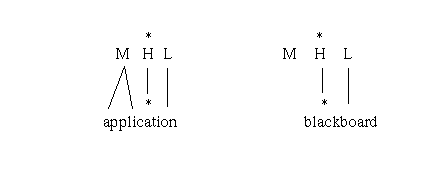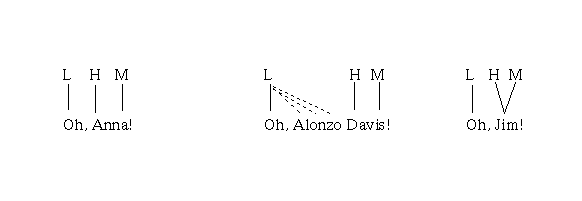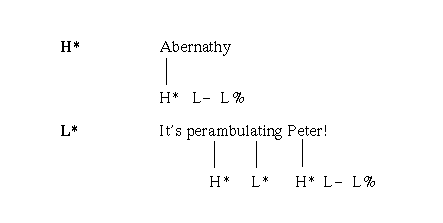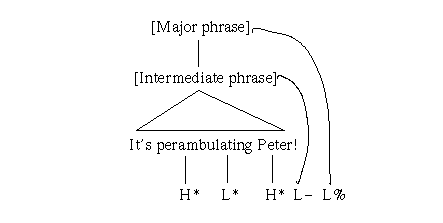An Autosegmental Approach to Intonation
1. Origins
Goldsmith (1981) proposed that English lexical stress could be characterised
by a MHL autosegmental melody, in which the H tone corresponds with the
strongest stress, marked with a *:

Liberman (1975) pursued the same approach to characterise English intonation
more generally. For example, he identified a LHM "calling" intonation,
in which the H tone docks onto the main stress, and the initial L tone
spreads in the usual autosegmental fashion to all pre-stress syllables:

The fruition of this line of research is seen in Pierrehumbert (1980)
and subsequent work from the same perspective (e.g. Liberman and Pierrehumbert
1984, Beckman and Pierrehumbert 1986, Pierrehumbert and Beckman 1988).
2. Types of tones
Pierrehumbert (1980) distinguished between different types of tonal
targets. We have seen various examples of dynamic accents, which are the
head elements of intonational phrases. In addition, Pierrehumbert proposed
to use H and L boundary tones at the beginning and end of major
phrases, as well as a H or L phrase accent at the end of each intermediate
phrase. Unlike standard autosegmental theory, Pierrehumbert did not
employ spreading to derive the tone of unaccented syllables, but saw
that as a matter of phonetic interpolation between phonologically-specified
targets. In other words, the phonological representation of intonation
is phonetically underspecified.
-
Phrase accents and boundary tones are edge elements that have a demarcative
function.
-
Pitch accents are head elements with culminative function.
Pitch accents were marked with a *; phrase accents were marked with a -;
boundary tones were marked with a %. *, -
and % are just diacritics, unrelated to f0value.
They only show how the tone is related to the text.

Phrase accents and boundary tones are not associated to segmental material,
like pitch accents, but to prosodic nodes:

3. Same text, different tunes
Refer to figs. 1.1 and 1.2 on the examples handout.
1.1 A could be the answer to a question ("Who was that?")
1.1 B could be an answer to a question, with an indication of incompleteness
1.1 C "calling" intonation.
1.1 D "incredulous"
1.1 E "Is it Anna?"
1.2 A Answer to a question ("What's this?")
1.2 C Expression of surprise (focus on another).
4. Same tune, different texts - compare figs. 1.4 A and B.
5. Boundary tones
Initial H%: see figs. 1.2 C, and 1.4 A and B.
Final L%: see figs. 1.1 A, C, 1.2 A, B, C, etc.
Final H% See figs. 1.1 B, D, E, etc.
6. Pierrehumbert's Bitonal Pitch Accents
L*+H- "Scoop". A low tone with
sharp rise to a high peak. See fig. 1.1 D.
L-+H* "Rising peak".
A high peak preceded by a sharp rise from a valley in the lowest part of
the pitch range.
H*+L- A H* that induces following
downstep. (Abandoned since Silverman et al. 1992). See fig. 1.1 C.
H-+L* Downstepped H that
induces downstep on later H's. Characteristic of catathesis e.g.
| I |
really |
believe |
Ebenezer |
is a |
dealer |
in |
magnesium |
|
|
| |
| |
| |
|
| |
|
| |
|
|
H* |
H-+L* |
H-+L* |
|
H-+L* |
|
H-+L* |
L- L% |
H*+H- (Abandoned after Liberman
and Pierrehumbert 1984).
7. The grammar of tonal sequences
Each (American) English intonational phrase, then, has the following
structure:
| Optional intial boundary tone: one of |
|
One or more pitch accents: one of |
|
A phrase accent: one of |
|
A final boundary tone: one of |
| H% |
|
H* |
|
H- |
|
H% |
| L% |
|
L* |
|
L- |
|
L% |
| Nothing |
|
L*+H- |
|
|
|
|
|
|
L-+H* |
|
|
|
|
|
|
H-+L* |
|
|
|
|
Pierrehumbert (1980) characterised this structure by a finite-state
transition network.
Recommended Reading:
Ladd (1992, 1996), Beckman and Pierrehumbert (1986)
References
Beckman, M. E. and G. M. Ayers (1994) Guidelines for ToBI labelling
(version 2.0) Electronic document /opt/tobi/TOBI-TRAINING/labelling_guide-V2.ASCII
on OUPLSun.
Beckman, M. E. and J. B. Pierrehumbert (1986) Intonational structure
in Japanese and English. Phonology Yearbook 3. 255-309.
Goldsmith, J. (1981) English as a Tone Language. In D. Goyvaerts, ed.
Phonology
in the 1980's. Ghent: Story-Scientia. Circulated in 1974.
Ladd, D. R. (1992) An introduction to intonational phonology. In G.
J. Docherty and D. R. Ladd, eds. Papers in Laboratory Phonology II:
Gesture, Segment, Prosody. Cambridge University Press. 321-334.
Ladd, D. R. (1996) Intonational Phonology. Cambridge University
Press.
Liberman, M. (1975) The Intonation System of English. PhD dissertation,
MIT. [IULC edition, 1978]
Liberman, M. and J. Pierrehumbert (1984) Intonational Invariance under
Changes in Pitch Range and Length. In M. Aronoff and R. T. Oehrle, eds.
Language
Sound Structure: Studies in Phonology Presented to Morris Halle by His
Teacher and Students. MIT Press. 157-233.
Pierrehumbert, J. B. (1980) The Phonology and Phonetics of English
Intonation. PhD dissertation, MIT. [IULC edition, 1987].
Silverman, K., M. Beckman, J. Pitrelli, M. Ostendorf, C. Wightman, P.
Price, J. Pierrehumbert and J. Hirschberg (1992) ToBI: A Standard for Labeling
English Prosody. In J. J. Ohala, T. M. Nearey, B. L. Derwing, M. M. Hodge
and G. E. Wiebe, eds. ICSLP 92 Proceedings: 1992 International Conference
on Spoken Language Processing. Volume 2. Department of Linguistics,
University of Alberta. 867-870.



